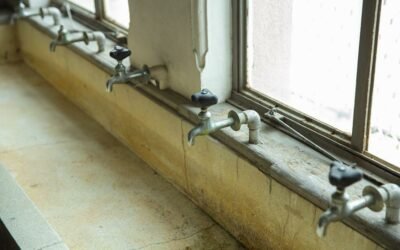Do you struggle with sleep apnea? Have you considered the possibility that mold may be to blame?
In this article, we will explore the potential link between mold exposure and sleep apnea. By understanding the basics of sleep apnea and recognizing mold-related symptoms, you can take steps to prevent and treat this debilitating condition.
With evidence-based information, we aim to shed light on the connection between mold and sleep apnea, empowering you to make informed decisions about your health.
Key Takeaways
- Sleep apnea is a common sleep disorder characterized by pauses in breathing or shallow breaths during sleep.
- Mold exposure may contribute to the development or worsening of sleep apnea by causing inflammation in the upper airways and obstructing breathing during sleep.
- Individuals living in moldy environments are more likely to develop sleep-disordered breathing, including sleep apnea.
- Mold exposure can exacerbate existing sleep apnea symptoms by causing nasal congestion and inflammation.
The Basics of Sleep Apnea
Sleep apnea is a common sleep disorder that affects your breathing while you sleep. It's characterized by pauses in breathing or shallow breaths during sleep, which can last for a few seconds to minutes. These pauses can occur multiple times throughout the night, disrupting your sleep and leading to daytime sleepiness and fatigue. Sleep apnea is typically caused by a blockage in the airway, either due to the relaxation of the throat muscles or the collapse of the soft tissues in the back of the throat.
There are three types of sleep apnea: obstructive sleep apnea, central sleep apnea, and complex sleep apnea syndrome. Obstructive sleep apnea is the most common type and occurs when the muscles in the throat fail to keep the airway open. Central sleep apnea, on the other hand, is caused by a failure of the brain to send proper signals to the muscles that control breathing. Complex sleep apnea syndrome is a combination of both obstructive and central sleep apnea.
Sleep apnea can have serious consequences if left untreated. It has been linked to an increased risk of high blood pressure, heart disease, stroke, diabetes, and other health problems. It can also lead to poor quality of life, as it can cause difficulty concentrating, irritability, and decreased productivity. If you suspect that you have sleep apnea, it's important to seek medical attention for a proper diagnosis and treatment.
Understanding Mold Exposure
To understand the potential link between mold and sleep apnea, you need to be aware of the effects of mold exposure on your respiratory system. Mold is a type of fungus that can grow in damp environments, such as bathrooms, basements, and kitchens. When you are exposed to mold, the spores released into the air can be inhaled, leading to various health issues.
Mold exposure can irritate and inflame your respiratory system, causing symptoms such as coughing, wheezing, and shortness of breath. It can also trigger allergic reactions in some individuals, leading to nasal congestion, sneezing, and itchy or watery eyes. These respiratory symptoms can disrupt your sleep, making it difficult to achieve a restful night's sleep.
To better understand the effects of mold exposure on your respiratory system, take a look at the table below:
| Effects of Mold Exposure on Respiratory System |
|---|
| Irritation and inflammation of airways |
| Coughing and wheezing |
| Shortness of breath |
| Nasal congestion |
| Sneezing |
| Itchy or watery eyes |
Potential Link Between Mold and Sleep Apnea
Exposure to mold can potentially contribute to the development or worsening of sleep apnea. While the precise mechanism isn't yet fully understood, research suggests that mold exposure may lead to inflammation in the upper airways, which can obstruct breathing during sleep and increase the risk of sleep apnea.
Several studies have explored the potential link between mold and sleep apnea. One study found that individuals living in damp and moldy environments were more likely to develop sleep-disordered breathing, including sleep apnea. Another study found that exposure to mold spores in the home was associated with an increased risk of sleep apnea in children.
Furthermore, mold exposure may exacerbate existing sleep apnea symptoms. Mold can irritate the respiratory system and cause nasal congestion and inflammation, which can worsen breathing difficulties during sleep. In addition, mold allergies can lead to increased mucus production, further narrowing the airways and increasing the likelihood of sleep apnea events.
It is important to note that mold exposure is just one potential risk factor for sleep apnea, and other factors such as obesity, smoking, and family history also play significant roles. However, if you suspect mold exposure may be contributing to your sleep apnea symptoms, it's advisable to consult with a healthcare professional who can assess your condition and provide appropriate treatment options.
Recognizing Mold-Related Symptoms
If you suspect mold may be causing your symptoms, it's important to recognize the potential signs of mold-related health issues. Mold exposure can lead to a wide range of symptoms, some of which may overlap with other medical conditions. Being aware of these symptoms can help you identify if mold is contributing to your health problems.
Here are five common signs of mold-related health issues:
- Respiratory symptoms: Mold can trigger allergies and respiratory problems such as coughing, wheezing, and shortness of breath.
- Nasal congestion: Mold spores can irritate the nasal passages, causing congestion, sneezing, and a runny nose.
- Skin irritation: Exposure to mold can cause skin rashes, itching, and irritation.
- Eye irritation: Mold spores in the air can irritate the eyes, leading to redness, itching, and watery eyes.
- Fatigue and headaches: Mold-related health issues can also manifest as fatigue, frequent headaches, and difficulty concentrating.
It is important to note that these symptoms can vary from person to person, and not everyone will experience the same set of symptoms. If you suspect mold exposure, it's recommended to consult with a healthcare professional for an accurate diagnosis and appropriate treatment.
Preventing and Treating Mold-Related Sleep Apnea
If you suspect mold may be causing your symptoms, it's important to take steps to prevent and treat mold-related sleep apnea.
The first step in preventing mold-related sleep apnea is to address the underlying mold problem in your environment. This may involve identifying and fixing any sources of moisture or water leaks in your home, such as plumbing issues or roof leaks.
In addition, it's important to maintain proper ventilation in your home to prevent the buildup of moisture that can lead to mold growth. This can be achieved by using exhaust fans in bathrooms and kitchens, opening windows to allow fresh air to circulate, and using dehumidifiers in areas that tend to be damp, such as basements or crawl spaces.
Once you have addressed the mold issue in your environment, it's important to seek treatment for any symptoms of sleep apnea that you may be experiencing.
Treatment options for mold-related sleep apnea may include continuous positive airway pressure (CPAP) therapy, which involves wearing a mask over your nose and/or mouth during sleep to deliver a continuous flow of air to keep your airway open. Other treatment options may include oral appliances, which are custom-fitted devices that help to keep your airway open, or surgery, in severe cases.
It is important to consult with a healthcare professional if you suspect mold-related sleep apnea, as they can provide a proper diagnosis and guide you in the appropriate treatment options.
Conclusion
In conclusion, while there's limited research on the direct link between mold and sleep apnea, there's evidence to suggest that mold exposure can exacerbate respiratory symptoms and potentially contribute to the development or worsening of sleep apnea.
It's important to recognize the symptoms of mold exposure and take necessary steps to prevent and treat any mold-related respiratory issues.
Further research is needed to fully understand the relationship between mold and sleep apnea.






0 Comments